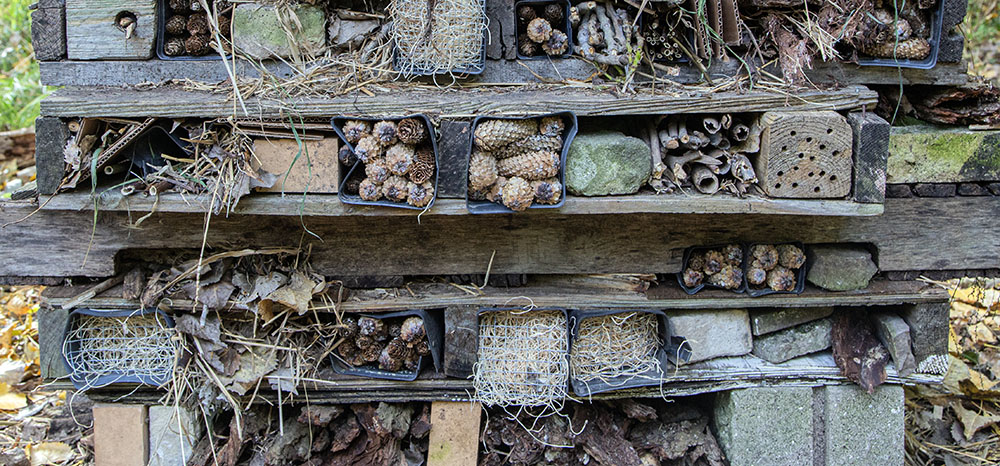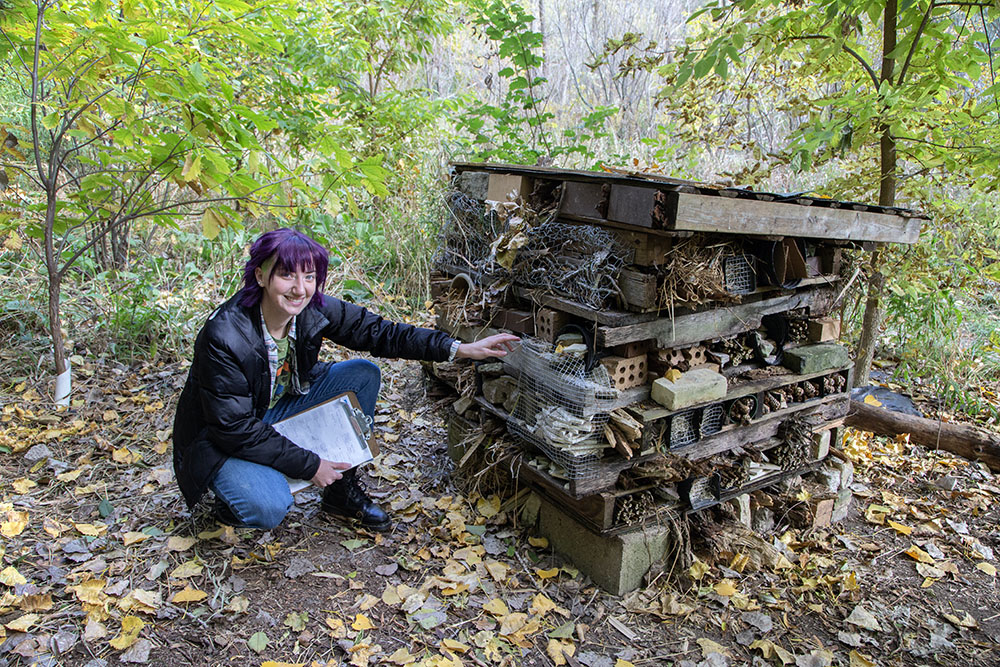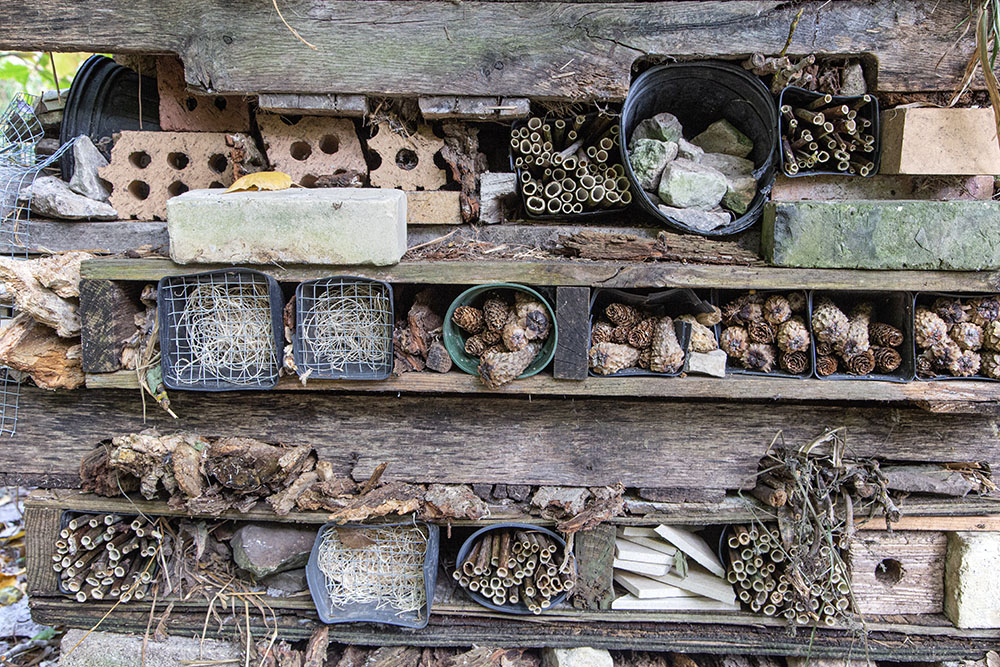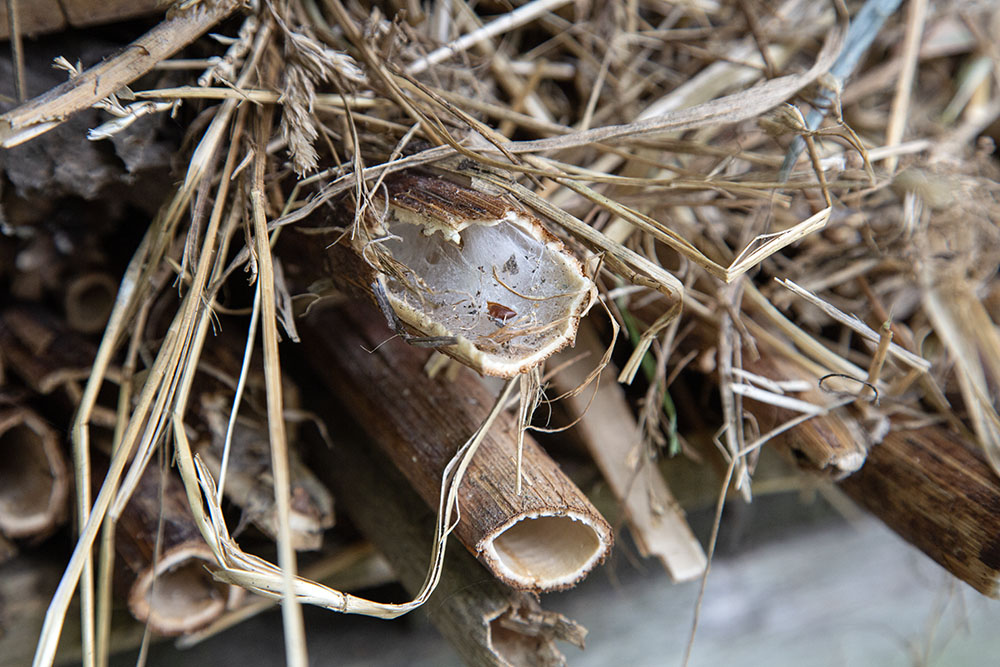
Luxury Bug Hotel on Milwaukee Riverfront!
October 31, 2022 | Topics: Stories
By Catie Petralia
With photographs by the author (CP) and by Eddee Daniel (ED)
A team of volunteers and students recently renovated the River Revitalization Foundation’s (RRF) five-star luxury riverfront bug hotel!
A Bug Hotel, also known as an ‘insect hotel’ is a habitat structure that supports insects and small creatures through the seasons, especially the Midwest’s unpredictable winter. It is an urban sanctuary for pollinators and all insects that face habitat loss, a changing climate, and pollution. Insects help stabilize the ecosystem, as integral links of the food chain and important pollination agents.

We built our original bug hotel almost ten years ago, so the structure needed some love. The original location was also now overgrown by stinging nettle (a native plant with irritating fibers), so it was moved about 200 yards north, right off the southern end of the Beerline Trail near the North Avenue pedestrian bridge.

The new and improved bug hotel has many diverse types of rooms with a variety of habitats for specific species. These include stacked hollow stems (cut from the invasive Japanese Knotweed plant) for solitary bees; metal chicken wire grates for earwigs; deadwood for beetles, fungi, centipedes, woodlice, and spiders; pinecones, straw and stacked twigs for ladybugs; cardboard slots for butterflies and lacewings; stones and tiles for amphibians. The structure itself was made from old wooden shipping pallets, roofing tiles left over from our sheds, other found materials, and secured with nails.


Our construction team of community volunteers and university students engaged in service learning, as contractors. RRF has hosted the service learning program with University of Wisconsin-Milwaukee (UWM) for ten years, and recently opened it to Milwaukee Institute of Art & Design (MIAD) students as well. Students assist with all land stewardship activities, as well as special projects such as the bug hotel.

Some of the students questioned the validity and purpose of the bug hotel. It is a fair question, given that we constructed the hotel amongst the dense woodland and wetland of the Milwaukee River shoreline, which has plenty of insect habitat.

My response is that this bug hotel will be a safer habitat for insects since it provides more protection from both predators and weather, having a roof and base layer. Its structure will not change drastically through winter, unlike trees and shrubs that lose their leaves. And although the Greenway appears to be a vast natural area, its resources are limited by the surrounding city, and it has many active human users that may infringe on wildlife’s habitat.

And if that was not convincing enough, I said at least the informative sign and QR code with directions might inspire people to build their own insect hotels in their gardens and backyards, where they are especially needed. The link provides instructions on how to build a smaller at-home version with natural materials. The ultimate purpose is to encourage people to support pollinators where there is less habitat.
With a changing climate, all creatures are more vulnerable and will need more support, especially the little beings like the insects and other pollinators. Everything is connected in nature, so when you help insects, you help birds and native plants, making them all more resilient to the effects of climate catastrophe.

If you would like to get involved, RRF operates a weekly volunteer program, where community members volunteer outdoors near the Milwaukee River. They conduct land stewardship activities such as invasive species removal, establishing native plants, trail maintenance, plant and seed propagation, and other projects as necessary. New volunteers are welcome all year. Just one virtual orientation is required before starting. Click here for more information.

Thank you for taking the time to read this! We hope you can visit the luxury bug hotel, located on the southern end of the Milwaukee River Greenway. Look for the Bug Hotel sign. I hope you enjoyed and learned a bit about bugs and RRF.
River Revitalization Foundation is a land trust located on the Milwaukee River and is a project partner of A Wealth of Nature.
Catie Petralia is Communication, Volunteer and Office Coordinator for RRF. She is originally from Illinois, and came to Milwaukee for college six years ago and now resides in the Riverwest neighborhood. She loves the abundant nature in the city and state, and enjoys exploring with her dog Cuda.
Eddee Daniel is a board member of Preserve Our Parks and former Artist in Residence for River Revitalization Foundation.

